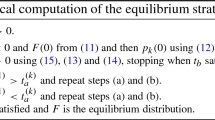Abstract
In this paper we model the operation of a mining stockyard by an \erk queue. We describe the stockpile configuration of the stockyard by a set of discrete parameters, taking values in the set of positive integers, which define the queueing system. Our goal is to optimise both the throughput and a penalised throughput of this queueing system, by selecting the optimal number and size of the stockpiles within the stockyard. This is accomplished by the development of several tools, including a local search algorithm that exploits the specific nature and constraints of the system.
Similar content being viewed by others
References
Balakrishnan, A., Francis, R. L. and Grotzinger, S. J. 1996. Bottleneck Resource Allocation in Manufacturing. Management Science 42-11:1611–1625.
Banaszak, Z. A. and Honczarenk, J. 1997. Design of a Performance Repetative Manufacturing System. Proceedings of the Institution of Mechanical Engineers Part B Journal of Engineering Manufacture 211-4:329–334.
Brimberg, J. and Mehrez, A. 1997. A Note on the Allocation of Queuing Facilities Using A Minisum Criterion. Journal of the Operational Research Society 48:195–201.
Buzacott, J. A., and Shanthikumar, J. G. 1992. Stochastic Models of Manufacturing Systems. New Jersey: Prentice-Hall.
Cassandras, C. G. 1993.Discrete Event Systems: Modelling and Performance Analysis. Boston: Irwin and Aksen Ass.
Cheng, D. W. and Yao, D. D. Tandem Queues With General Blocking: A Unified Model and Stochastic Comparisons. Discrete Event Systems: Theory and Applications 2:207–234.
Conway, R., Maxwell, W., McClain, J. O. and Thomas, L. J. 1988. The Role of Work-In-Progress Inventory In Serial Production Lines. Operations Research 36:229–241.
Glasserman, P. and Yao, D. D. 1996. Structure Buffer-Allocation Problems. Discrete Event Systems: Theory and Applications 6-6:9–41.
Ho, Y. C., Sreenivas, R. and Vakili, P. 1992. Ordinal Optimization of Discrete Event Dynamic Systems. Journal of Discrete Event Systems 2-2:61–68.
Jarvis, J. P. Optimal Assignment in aMarkovian Queuing System. Computers and Operations Research 8:17–23.
Karabati, S., Kouvelis, P. and Yu., G. 1995. The Discrete Resource Allocation Problem in FlowLines. Management Science 9-9:1417–1430.
Kleinrock, L. 1975. Queueing Systems Volume 1: Theory, New York: John Wiley & Sons.
Kumar, R., Garg, V. K. and Marcus, S. J. 1995. Finite Buffer Realization of Input-Output DES. IEEE Transactions on Automatic Control 40-6:1042–1053.
Lauzon, S. C., Ma, A. K. L. and Benhabib, B. 1996. Application of Discrete Event System Theory to Flexible Manufacturing. IEEE Control Systems Magazine 16-1:41–48.
Nogami, S., Komota, Y. and Hoshiko, Y. 1984. Analysis of the GI/E k/1 Queue With Finite Waiting Room by the Supplementary Variable Approach. Electronics and Communications in Japan 67-A1:10–19.
Ohsone, T. 1981. The GI/E k /1 Queue With Finite Waiting Room. Journal of the Operations Research Society of Japan 24-4:375–390.
Papadimitriou, C. and Steiglitz, K. 1982. Combinatorial Optimisation Algorithms and Complexity. New Jersey: Prentice Hall.
Panayiotou, C. G. and Cassandras, C. G. 1996. Optimization of Kanban-Based Production Systems. Proceedings WODES '96, pp. 39–44.
Righter, R. 1989. A Resource Allocation Problem In A Random Environment. Operations Research 37-2:329–338.
Yang, M. S., Lee, L. and Ho, Y. C. 1997. On Stochastic Optimisation and Its Application to Manufacturing. Lectures In Applied Mathematics, Mathematics of Stochastic Manufacturings Systems 33:317–331.
Zerhourni, N., Ferney, M. and Elmoudri, A. 1995. Transcient Analysis of Manufacturing Systems Using Petri Nets. Mathematics and Computers in Simulation 39-5/6:635–639.
Author information
Authors and Affiliations
Rights and permissions
About this article
Cite this article
Binkowski, M., McCarragher, B.J. A Queueing Model for the Design and Analysis of a Mining Stockyard. Discrete Event Dynamic Systems 9, 75–98 (1999). https://doi.org/10.1023/A:1008397332376
Issue Date:
DOI: https://doi.org/10.1023/A:1008397332376




